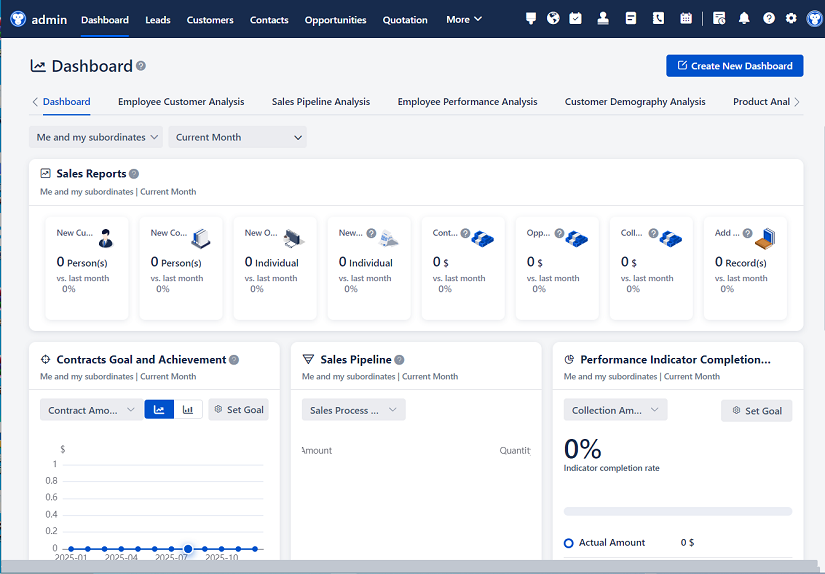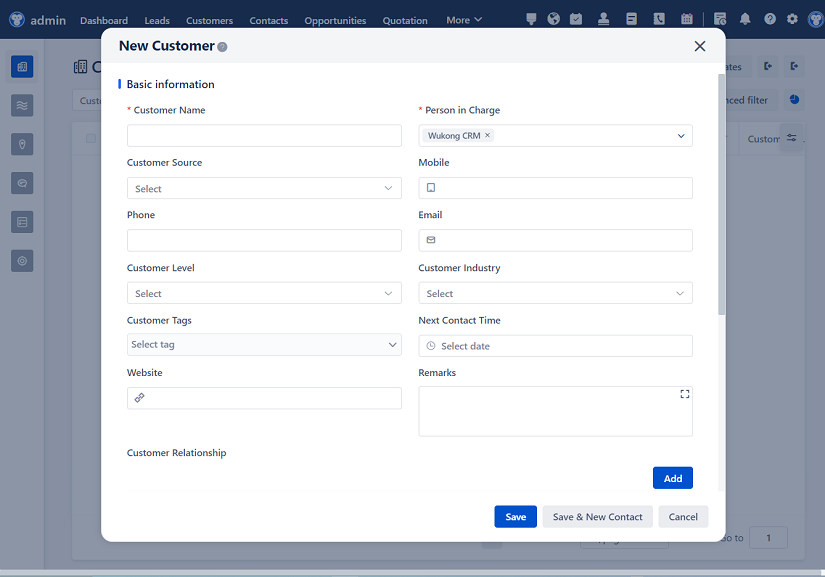
△Click on the top right corner to try Wukong CRM for free
So, let me tell you something — if you’ve ever felt like your customer relationships are slipping through the cracks, you’re definitely not alone. I’ve been there too. You know, you start with good intentions — logging calls, tracking emails, trying to keep up with follow-ups — but before you know it, things get messy. That’s exactly why so many businesses these days are turning to CRM software. But here’s the thing: off-the-shelf CRM tools? They can be helpful, sure, but they don’t always fit like a glove. That’s where custom CRM development comes in.
Honestly, when I first heard about custom CRM development, I thought it was just for big corporations with deep pockets. But over time, I realized that even small and mid-sized companies can benefit from it — especially when their workflows are unique or their customer interactions are more complex than what standard tools can handle.
Free use of CRM system: Free CRM
Now, let me walk you through how the whole custom CRM development process actually works — because trust me, it’s not as intimidating as it sounds. In fact, once you understand the steps, it kind of makes perfect sense.

It all starts with a conversation — yeah, just a regular chat. Usually, it’s between you and a development team or a solutions consultant. The goal? To really understand what you’re trying to achieve. Like, what’s bothering you about your current system? Are sales reps missing follow-ups? Is customer data scattered across spreadsheets? Are marketing campaigns hard to track? These are the kinds of questions that come up.
And honestly, this phase is super important. If the developers don’t truly get your pain points, the end product might look nice but won’t solve your real problems. So take your time here. Be honest. Share examples. Maybe even show them how your team currently manages leads or handles support tickets.
Once everyone’s on the same page, the next step is gathering requirements. This isn’t just a checklist — it’s more like building a blueprint. You’ll talk about features you need: contact management, lead scoring, task automation, reporting dashboards, maybe even integration with your email or calendar. And don’t forget mobile access — people are on the go these days, and your CRM should be too.
Here’s a tip: prioritize. Not everything has to be built in version one. Focus on the core functionalities that will make the biggest impact right away. You can always add more later.
After that, the team usually creates a detailed project plan. This includes timelines, milestones, budget estimates, and who’s responsible for what. It’s not set in stone — things can change — but having a roadmap helps keep everyone aligned and reduces surprises down the line.
Then comes the fun part — design. Now, I don’t mean just colors and logos (though those matter too). I’m talking about user experience. How will your sales team actually use this thing every day? Will it feel intuitive, or will they dread logging in?
A good development team will create wireframes or mockups — basically rough sketches of what the screens will look like. You’ll review them, give feedback, maybe say, “Hey, can we move this button up?” or “This field should be mandatory.” It’s collaborative, and it should feel like you’re shaping the tool together.
Once the design is approved, coding begins. This is where the magic happens behind the scenes. Developers start building the actual software — setting up databases, writing code, connecting APIs. It’s technical, sure, but you don’t need to understand every line of code. Just know that progress is being made, and regular updates should keep you in the loop.
And speaking of updates — communication is key throughout this whole process. You’re not supposed to disappear for three months and then suddenly get a finished product. No, no. Good teams check in weekly or bi-weekly. They show you what’s been built, answer your questions, and adjust based on your feedback.
One thing I’ve learned? Don’t wait until the very end to test things out. Most teams use an agile approach, which means they build the CRM in chunks — called sprints. After each sprint, you get to see a working piece of the system. Maybe it’s just the contact list at first, then later you add tasks and reminders. Seeing real progress keeps motivation high and catches issues early.

Now, integration is another big deal. Your CRM probably needs to talk to other tools — like your email platform, your website forms, maybe even your accounting software. A custom CRM can be built to connect seamlessly with these systems, so data flows automatically instead of requiring manual entry. That’s a huge time-saver, and honestly, it cuts down on errors too.
Security? Oh, absolutely. When you’re dealing with customer data, you can’t afford to cut corners. A reputable development team will build with security in mind from day one — using encryption, secure authentication, role-based access controls. You should feel confident that sensitive info is protected.
As development wraps up, the testing phase kicks in. This isn’t just the devs clicking around — it’s real users from your team trying out the system. They’ll look for bugs, confusing workflows, anything that doesn’t feel right. Feedback gets collected, fixes are made, and the system gets polished.
Then comes deployment — launching the CRM for your entire team. This can be exciting, but also a little nerve-wracking. That’s why training is so important. Your staff needs to know how to use the new system effectively. A good provider will offer training sessions, user guides, maybe even video tutorials.
And don’t expect perfection on day one. There might be a few hiccups — someone can’t find a report, a notification didn’t go out. That’s normal. The key is having support ready to help. Most custom CRM projects include a post-launch support period, so you’re not left hanging.

After a few weeks, you’ll start seeing the benefits. Sales reps close deals faster because they have all the info they need. Managers get clear insights from real-time dashboards. Customer service improves because history is easy to access. It’s not magic — it’s just smart design meeting real needs.
But here’s the best part: a custom CRM grows with you. Need a new feature six months from now? Want to tweak a workflow? Since it’s built specifically for your business, changes are easier to implement than with rigid off-the-shelf software.
I’ll be honest — custom development does cost more upfront than buying a subscription. But think long-term. How much time are you wasting on inefficient processes? How many leads are slipping through? When you factor in productivity gains and better customer retention, the ROI often makes it worth it.
Also, ownership matters. With a custom CRM, you own the code and the data. You’re not locked into a vendor’s pricing model or at risk of sudden feature removals. You control your own destiny.
Of course, choosing the right development partner is crucial. Look for a team with experience in CRM projects, good references, and a clear communication style. Ask to see demos of past work. Make sure they listen more than they talk in the beginning — because your business is unique, and they should treat it that way.
Another thing — scalability. Even if you’re a small team now, what if you grow? A well-built custom CRM can handle hundreds or even thousands of users without breaking a sweat. It’s built to scale.
And customization isn’t just about features — it’s about culture. Your CRM should reflect how your team actually works, not force them into someone else’s idea of efficiency. That’s why input from end-users during development is so valuable.
Let me tell you — when your team starts loving the tool instead of dreading it, you know you’ve done something right. That’s the dream, right? A CRM that feels like a helper, not a chore.
So, is custom CRM development right for you? Well, if your business has unique processes, high-volume customer interactions, or specific compliance needs, then yeah — it probably is. But even if you’re not sure, just having a conversation with a developer can help clarify things.
At the end of the day, it’s about making your team’s lives easier and your customers happier. And honestly, isn’t that what every business wants?
FAQs (Frequently Asked Questions):
Q: How long does custom CRM development usually take?
A: It really depends on the complexity, but most projects take between 3 to 6 months. Simple ones might be done in 8–10 weeks, while larger systems with integrations could take 9 months or more.
Q: Isn’t custom CRM super expensive?
A: It can be more costly upfront than buying a subscription, but think about the long-term value. You’re investing in a tool that fits your exact needs, saves time, and scales with your business — which often pays for itself.
Q: Can I integrate my custom CRM with tools like Gmail or Slack?
A: Absolutely! One of the biggest advantages of custom development is seamless integration. Whether it’s email, calendars, marketing tools, or internal systems, your CRM can be built to connect with them.

Q: What if my business changes after the CRM is built?
A: No problem. Since it’s custom, the system can evolve. Most development teams offer ongoing support and can add new features or modify workflows as your needs shift.
Q: Do I need technical skills to manage a custom CRM?
A: Not really. The interface should be user-friendly, and your team will get training. For backend stuff, your development partner usually provides maintenance and support.
Q: Who owns the CRM after it’s developed?
A: You do. Unlike SaaS platforms where you rent access, a custom CRM is typically delivered with full ownership of the source code and data.
Q: Can a custom CRM work on mobile devices?
A: Yes, and it should. Most modern custom CRMs include responsive design or dedicated mobile apps so your team can access it from anywhere.
Q: How do I know if my company is ready for a custom CRM?
A: If you’re constantly fighting with your current system, losing data, or spending too much time on manual tasks, it’s probably time to explore a custom solution.
Related links:
Free trial of CRM
Understand CRM software

△Click on the top right corner to try Wukong CRM for free